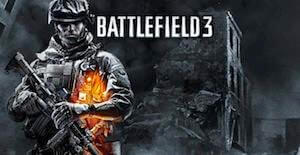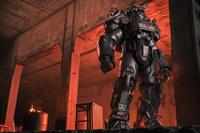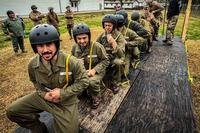
By Sean Nack
How much realism do you like in your entertainment? For me, it’s a “you got peanut butter in my chocolate” situation. There’s a balance to be struck, a form of realistic whimsy. Take, for example, the sandbox. A child can play in the sandbox with an exact replica of a John Deere 75-D excavator (oh yeah, I looked it up), and build a moat for a wizard’s castle. He’s taking a realistic tool into an imaginative environment that allows him the freedom to do whatever he wants.
Battlefield 3 (BF3) works in much the same way. BF3 is a first-person shooter, yes, but it’s an FPS that allows you to hop into a tank, a jet, a RHIB, or an attack helicopter without even attending an operator’s course! So in that sense BF3’s realism takes a distinct nose-dive, but it does so in service of a much broader gameplay experience. Unlike MW3 (with which we are forced to compare BF3, even though trying to draw a parallel between the two is like trying to find common ground between apples and an entire Thanksgiving dinner), there’s more to the game than running and gunning through a collection of tight semi-urban environments. There’s something to be said for that form of gameplay; MW3 is fast-paced, frenetic action that can’t be topped as far as pure, adrenaline-pumping action goes, but BF3 goes much, much deeper.
%embed1%
Gameplay is based around 4 character classes: Assault (uses assault rifles, has a 40mm grenade launcher, a defibrillator to revive downed teammates, and a first-aid kit that restores health in a given area), Engineer (uses carbines, anti-tank missiles, anti-tank mines, an EOD bot, and a handheld welding torch for repairing vehicles), Support (uses LMGs, a mortar, claymore mines, and an ammo box that replenishes teammates’ ammunition) and Recon (uses sniper rifles, a UAV, motion sensor, and a radio beacon that serves as a mobile spawn point). You’ll notice that that is a ridiculously long sentence, but that’s indicative of BF3’s biggest advantage: options.
All of these options rotate around teamwork. You get just as many points for reviving teammates or suppressing the enemy as you do for actually killing enemies. BF3 wants you to participate with the people you play with, to forge temporary electronic alliances in the heat of battle. In that sense, BF3 is the most realistic game ever made.

There are a variety of other small examples of attention to detail. Firing around an enemy, especially with an LMG, creates a “suppression” effect that blurs the screen and narrows the focus of the suppressed player, creating something of a panicked reaction, much like a stream of 7.62mm would in real life. To put the game to a real test, I hopped into the Recon class to put the sniper rifles to the test.
Now, while there isn’t a rangefinder in-game, they do give you a ten-point bonus per yard for headshots. As a sniper using an 8x mildot scope and a 7.62mm rifle, I used the first mildot down from center and scored a headshot. Running this info by our resident sniper king, Brandon Webb, who confirmed that at 100 yards (no weather data included because that would be way too much for BF3 to handle) you’d generally use about 1-2 minutes of angle up from zero at 100 yards, with each mildot representing about 4 minutes of angle. So my shot represents a pretty close approximation of ballistics at that range.

So at the small scale, the multiplayer gameplay is fairly realistic, but tactically, there’s not much in the way of organization that the players themselves don’t create. There’s the suppression mechanic, so while suppressive fire exists as a tactic, whether or not it gets employed tactically is up to the player. Usually gameplay is a bum-rush to the objective, with some people forcing their way in while some players provide some suppressive or sniper fire from a distance.
In the campaign, the developer DICE went for a tightly scripted storyline that is occasionally so tightly scripted that it takes you out of the gameplay; on the other hand, they clearly did their homework with regards to MOUT tactics, although at this stage of the tactical-shooter game, that kind of thing is par for the course. Middle school kids know how to breach and clear, y’know? Not that I’m saying I’d be their 1 man, but they know what it looks like. Frankly the campaign is nothing to write home about, but BF3 is, historically, all about the multiplayer.

The gear on the character models is entirely standard-issue USMC, but the Russian troops have a bit more sinister bent as the game’s villains, with gas masks and camo hoodies that I doubt the Russians are actually fielding. The main weapons range from standard issue M16A4s and AN-94s to less common weapons like the SG553, HK53, F2000, and PKP Pecheneg.
The weapons behave realistically with the exception of some of the explosives. One of the hallmarks of the modern Battlefield franchise is destructibility, the ability to bring down entire buildings with explosives. Having fired my share of 40mm, I’m pretty sure that even an HE/DP round isn’t going to bring down a concrete and rebar façade in Paris. That being said, I’ve seen 40mm hit mudbrick walls and blow them apart, and I’ve seen them slightly discolor others. Who knows what the building codes are on Sharqi Peninsula? Destructability does add yet another layer to BF3’s 3-tier wedding cake of gameplay.

So is BF3 all that realistic? It’s not trying to be a military simulator. Instead, BF3 gives you a realistic set of tools to do amazingly fun and unrealistic things. Blow up a building with an M320 and some anti-tank mines! Throw in a “WHOOOOO!” and you’ve got the military sandbox that you’ve always wanted.
-Sean Nack is an experienced gaming journalist and former 10th Mountain 11B with 16 months at FOB Tillman in OEF VII-VIII. Read more from Sean at Kit Up!




